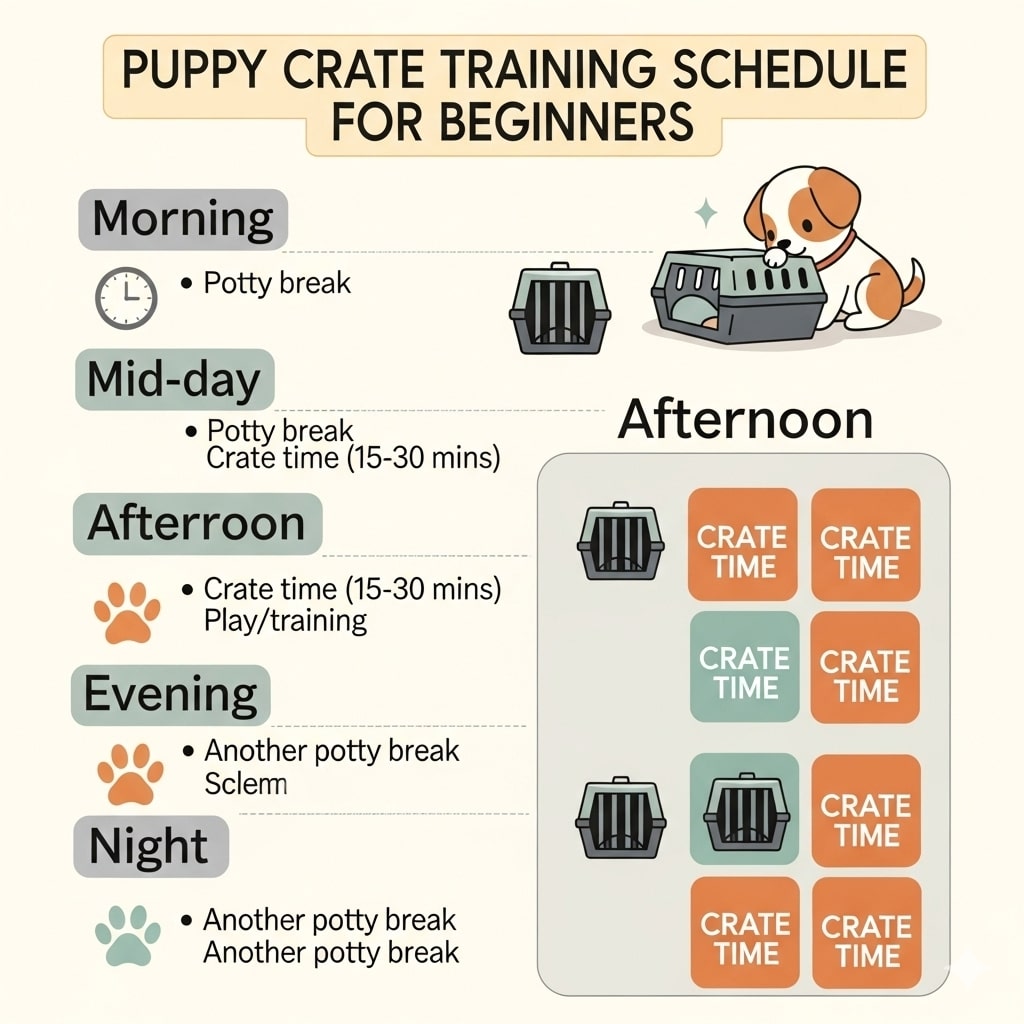Crate training is one of the most effective methods for teaching your puppy discipline, comfort, and proper housebreaking habits. For beginners, understanding the right puppy crate training schedule is crucial to ensure your pup develops good behaviors while feeling safe and secure. In this guide, we’ll cover everything from the basics of crate training to a detailed daily schedule, troubleshooting tips, and expert advice.
Why Crate Train Your Puppy?
Crate training offers numerous benefits for both you and your puppy:
- Potty Training Aid: Puppies naturally avoid soiling their sleeping area. A crate helps them learn to control their bladder and bowels.
- Security and Comfort: A crate becomes a safe haven, a den where your puppy can relax and feel secure.
- Prevents Destructive Behavior: When you can’t supervise your puppy, a crate prevents them from chewing furniture or getting into trouble.
- Travel Safety: A crate provides a secure and familiar space for your puppy during car rides or other travels.
- Easier Vet Visits: A crate-trained puppy is generally more comfortable and less stressed during vet visits.
Discover More: Puppy Potty Training Tips: Complete Guide for New Owners

Learn More: Keep Your Dog Healthy: Vet-Approved Tips for 2025
Choosing the Right Crate
Selecting the appropriate crate is crucial for successful crate training. Consider these factors:
- Size: The crate should be large enough for your puppy to stand up, turn around, and lie down comfortably, but not so large that they can eliminate in one corner and sleep in another. If you’re getting a crate for a puppy that will grow, consider a crate with a divider.
- Material: Options include wire, plastic, and soft-sided crates. Wire crates offer good ventilation and visibility, while plastic crates provide more privacy and are often preferred for travel. Soft-sided crates are lightweight and portable but may not be suitable for puppies prone to chewing.
- Durability: Choose a crate made from sturdy materials that can withstand your puppy’s chewing and scratching.
- Ease of Cleaning: Accidents happen. Select a crate with a removable, washable tray for easy cleaning.
Discover More: How to Potty Train a Puppy Fast: Complete Guideline
The Ultimate 2025 Puppy Crate Training Schedule
This schedule is a guideline and may need to be adjusted based on your puppy’s individual needs and personality. Consistency and patience are key.
Week 1: Introduction to the Crate (Positive Association)
- Day 1-3: Crate Exploration:
- Place the crate in a common area where your family spends time.
- Leave the door open and make it inviting with a soft blanket or bed inside.
- Toss treats and toys inside the crate to encourage your puppy to explore it on their own.
- Never force your puppy into the crate.
- Day 4-7: Feeding in the Crate:
- Start feeding your puppy their meals inside the crate.
- If your puppy is hesitant, place the food bowl just inside the entrance and gradually move it further in as they become more comfortable.
- Once your puppy is eating comfortably in the crate, close the door while they eat. Open it immediately after they finish.
Week 2: Short Crate Stays (Building Confidence)
- Day 8-10: Short Crate Stays with You Present:
- Lure your puppy into the crate with a treat or toy.
- Close the door for a few seconds, then open it immediately.
- Gradually increase the duration to a few minutes, staying in the same room.
- Talk to your puppy in a calm and reassuring voice.
- Day 11-14: Short Crate Stays with You Absent:
- Once your puppy is comfortable with short crate stays while you’re present, start leaving the room for short periods.
- Start with just a few minutes and gradually increase the time.
- Before leaving, give your puppy a treat or toy to keep them occupied.
- When you return, remain calm and avoid making a big fuss.
Week 3: Increasing Crate Time (Establishing Routine)
- Day 15-21: Longer Crate Stays:
- Gradually increase the amount of time your puppy spends in the crate during the day.
- Aim for crate stays of 1-2 hours at a time.
- Provide a safe chew toy to keep your puppy entertained.
- Continue to feed your puppy meals in the crate.
- Ensure your puppy has plenty of opportunities to eliminate outside before and after crate time.
Week 4 and Beyond: Overnight Crate Training (Consistency is Key)
- Nighttime Crate Training:
- Place the crate in your bedroom so your puppy feels close to you.
- Take your puppy out to eliminate right before bedtime.
- Lure your puppy into the crate with a treat or toy.
- Ignore any whining or barking, unless you suspect your puppy needs to eliminate.
- If your puppy whines, take them outside to eliminate, but do so without talking or playing. Return them to the crate immediately afterward.
- Gradually move the crate to your desired location over several nights.
Troubleshooting Common Crate Training Issues
- Whining and Barking: Ignore whining and barking unless you suspect your puppy needs to eliminate. Responding to the noise will only reinforce the behavior.
- Refusal to Enter the Crate: Make the crate more inviting with treats, toys, and comfortable bedding. Never force your puppy into the crate.
- Accidents in the Crate: Clean the crate thoroughly with an enzymatic cleaner to eliminate odors. Ensure your puppy has plenty of opportunities to eliminate outside. Reduce crate time if necessary.
- Anxiety: If your puppy exhibits signs of severe anxiety, such as excessive panting, drooling, or destructive behavior, consult with a veterinarian or certified dog trainer.
Tips for Success in 2025
- Positive Reinforcement: Use treats, praise, and toys to reward your puppy for positive behavior.
- Consistency: Stick to a consistent schedule and routine.
- Patience: Crate training takes time and patience. Don’t get discouraged if your puppy doesn’t take to it immediately.
- Supervision: Always supervise your puppy when they are outside of the crate.
- Avoid Punishment: Never use the crate as punishment. This will create a negative association with the crate.
- Consider Professional Help: If you’re struggling with crate training, consider seeking guidance from a certified professional dog trainer.
By following this comprehensive guide and remaining patient and consistent, you can successfully crate train your puppy and provide them with a safe and comfortable space they can call their own. Good luck!
